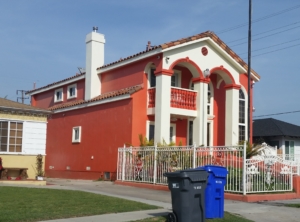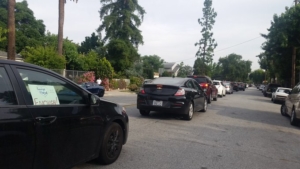The Real Suburbs: Unpacking Distortions and Truths about America’s Suburbs
By Becky Nicolaides
In recent weeks, suburbia has become the latest political football in our polarized political universe. In a Rose Garden address in mid-July, President Trump accused Democratic presidential candidate Joe Biden of seeking to “abolish the suburbs”— referring to Biden’s support of policies to ensure more racially diverse, affordable housing in suburban areas.[i] And on August 12, 2020, Trump tweeted: “The ‘suburban housewife’ will be voting for me. They want safety & are thrilled that I ended the long running program where low income housing would invade their neighborhood. Biden would reinstall it, in a bigger form, with Corey Booker in charge!”
In Trump’s mind, the Democrats would destroy America’s idealized suburbs—a pillar of white Americanism, a racially pure space worthy of protection.
While this may be an attempt to woo the all-important female suburban vote, a task that looms large in the upcoming election, Trump missed the mark in a few ways: one, the suburbs have already become quite diverse, and two, the suburbs are not as politically straight-forward as he might imagine. Trump might want to turn the clock back to 1950s “Ozzie and Harriet” America, when overt racist practices kept the suburbs lily white nationwide. But it’s 2020 and times have changed; Ozzie-and-Harriet suburbia is a whisper of the past.[ii] The suburbs are hardly a monolith, and many suburban women look nothing like June Cleaver these days.
If the Trump administration did its homework, they would understand that the suburbs house a wide cross-section of America itself—including those who belong to groups the President repeatedly derides. Does his administration, then, really want to “save the suburbs” for the 51 percent of immigrants who live in suburbs? Or the Latinx, Black, and Asian American families, or families living in poverty who have moved into suburban neighborhoods over the past decades? The numbers tell a powerful story. From 1970 to 2010, the proportion of all suburbanites in the US who were Black, Latinx and Asian American rose from just under 10 percent to 35 percent. In Los Angeles, the vanguard of suburban change, those numbers jumped from 26 percent to 70 percent.
In my research on the history of suburbia in Los Angeles since 1945, I’ve encountered rich stories about these places—some familiar, others unexpected. In some cases, suburbia changed radically through these demographic transformations. In others, old ways of life and political cultures persisted. Unpacking these histories shows how important it is to fully understand the context and nuances of a place and its history before proposing policies that rely on presumed demographics and biases.
My research on Los Angeles shows that suburban change happened most dramatically in the realms of demography and class. For example, by 2000, the “vanilla suburb” had essentially dissolved; virtually every suburban town had some ethno-racial diversity. Even more profoundly, by 2010, people of color outnumbered whites as homeowners in LA’s suburbs for the first time in the history of the metropolitan area. Given how deeply race and property ownership intertwined, this racial crossover carries deep significance. We know that for generations before 1970, suburbia was synonymous with white advantage. For much of their history, the suburbs made white racial exclusivity a vital part of their appeal. Suburbia came to represent a wage of whiteness that conferred numerous advantages through property ownership, superior schools, safe neighborhoods and preferential tax breaks, passed down from one generation to the next. So when a majority of suburban homeowners in an entire major metro emerged as non-white—for the first time ever—something big was shaking out.

For me, significant questions followed: How did these new suburbanites behave in social and political life within their communities? Would they create new community cultures or replicate older entrenched ones? The answers were mixed. In some cases, Latinx and Asian American homeowners perpetuated habits of NIMBYism and exclusion in their communities, sometimes aimed against their own co-ethnics who might be poorer, less acculturated, non-citizens, or homeless.
Yet in other cases, more progressive impulses have emerged. Most recently, an outpouring of #BLM activism cropped up across LA suburbia—from sidewalk protests in elite La Canada-Flintridge, to miles-long car caravans snaking through the streets of interracial northwest Pasadena, and another through staid Claremont. These interracial mobile protests united drivers and residents in communal displays of yelling, honks, Black power fist pumps, and shared righteous anger. Activists in Pasadena followed up with a robust campaign at City Hall to establish a Community Police Oversight Commission with a full-time independent Police Auditor, as a means of ensuring community justice and police accountability.

In Southeast LA, youth activists are working to bring the righteous anger of #BLM to their own suburban backyards. In South Gate, activists like Veronica Hernandez and Amanda Tapia are mobilizing residents behind a campaign for a “People’s Budget,” which would redirect municipal funding away from the police and toward basics like affordable housing and community development. In neighboring working-class suburbs, similar groups have emerged, e.g., SELA Chisme, Lynwood Youth 4 Radical Change, Downey Resistance, and Compton Rising. These collectives attract mostly Latinx youth in the their early 20s, but also African Americans and some whites.[iii]
South Gate’s story reveals the nuance and complexity of this struggle. Like many suburbs in southeast LA, South Gate morphed from its 1950s white Brady Bunch image into a predominantly Latinx community. Yet, the politics of that suburb defy stereotypes, particularly in its support for the police. According to news reports in the 1980s and early 1990s, for example, Latinx suburbanites were drawn to the community for its “strong, responsive police force,” which helped make South Gate a safer place and “a good place to raise children.” South Gate’s suburban moms—majority Latina after 1980—supported the police in its mission to protect homes, neighborhoods, and children, just like suburbanites pretty much everywhere. Mexican-born Celine Leyva, for example, played a leadership role in a group called Community in Action, formed in 1997. When a police officer was gunned down in front of her suburban home, she was deeply shaken and became heavily involved in this group. In 1998 they began holding marches—in partnership with the police—“against violence and abuse; and to improve living conditions of the community and the safety of our children.” A typical march started with 50 to 60, gathered others along the way, ending with 300 to 400.[iv] South Gate had fewer instances of police abuse than other southeast suburbs. And in 2000, when the police helped oust a corrupt cabal that had taken over City Hall, they became deeply endeared to the community. This pro-police sentiment persists to the present day—a December 2019 survey taken by the Pat Brown Institute found that 74 percent of residents in the Southeast suburbs believed that law enforcement usually or sometimes treated residents fairly (as opposed to unfairly).[v] This history creates certain challenges for today’s youth activists seeking a broader re-imagining of community priorities, and also signals the complexity of political cultures within diverse suburbs.
In addition to changing race and ethnic profiles, class is another major vector of transformation in suburbia. Since the 1950s, the suburbs have evolved from a bastion of the American middle-class to a space of vast economic inequality. Los Angeles data bear this out, with a predominance of middle-class suburbs across the County in the 1950s and 1960s.[vi] After 1970, suburban poverty accelerated and stood in stark contrast to exploding suburban wealth. By 2010, suburbia encompassed economic inequality itself, what Andy Wiese and I dubbed “suburban disequilibrium.”[vii]
The rise of suburban homelessness in LA’s San Fernando Valley, which one author dubbed “America’s Suburb,” offers a striking illustration of these class extremes.[viii] Among the acres and acres of mass-produced homes, homelessness has become endemic, offering a visual disconnect of poverty set against iconic suburban backdrops. Filmmaker Eva Saks captures this juxtaposition in her stunning photographs of Valley homelessness.


Suburbia, then, is home to the poor and the rich, to immigrants, and to people of all ethnic and racial backgrounds. The “suburban vote” is something of a misnomer—yes, people in the suburbs vote, but they represent an ever-expanding cross-section of the American mosaic and no longer connote a white middle-class profile. The old-timey version of Ozzie-and-Harriet suburbia has (thankfully) gone the way of the Confederacy, and much as Trump would like to bring both back, history has pulled far, far ahead of him.
Becky Nicolaides received her PhD in History from Columbia University in 1993. She is a historical scholar, writer, and consultant. She serves as co-editor for the “Historical Studies of Urban America” series published by University of Chicago Press and is the co-coordinator of the LA History and Metro Studies group at the Huntington Library. She is a CSW Research Affiliate and received a Tillie Olsen Research Grant from CSW in 2020.
The author would like to thank Eva Saks and Desmond Weisenberg for their helpful comments.
[i] For recent media coverage, see Aaron Wiener, “Biden Wants to Desegregate the Suburbs. Naturally, Trump Is Furious,” Mother Jones, July 1, 2020, https://www.motherjones.com/politics/2020/07/biden-wants-to-desegregate-the-suburbs-naturally-trump-is-furious/; Kriston Capps, “What Does Trump Think the ‘Suburban Lifestyle Dream’ Means?” Bloomberg City Lab, July 29, 2020, https://flipboard.com/@citylab/what-does-trump-think-the-suburban-lifestyle-dream-means/a-Vy_QpA36T4mifqASoz4lOQ%3Aa%3A910330703-e57f08e552%2Fbloomberg.com.
[ii] Of many works on this theme, see for example Mike Davis, “Ozzie and Harriet in Hell,” Harvard Design Magazine 1 S/S (1997).
[iii] Author interview with Veronica Hernandez and Amanda Tapia, via Zoom, August 6, 2020.
[iv] Sam Quinones, Antonio’s Gun and Delfino’s Dream: True Tales of Mexican Migration (Albuquerque: University of New Mexico Press, 2007), 100-103; Celine Leyva oral history, conducted by Becky Nicolaides (Crystal Yanez translator), May 23, 2017, South Gate, CA; Community in Action flyers and meeting records, from Celine Leyva personal files; Sid Friday, “South Gate Citizens March Against Violence,” Southside News, November 1998; Jesse Linares, “Vecinos en Accion,” La Opinion, September 27, 2000 (from personal files of Celine Leyva).
[v] Los Angeles Times, December 5, 1982, September 21, 1991; South Gate Press, May 9, 1984. See the December 2019 survey at: https://calstatela.patbrowninstitute.org/what-we-do/sela-initiative/sela-surveys/.
[vi] Yet even in that iconic postwar moment, cracks were forming. Data since 1959 show the presence of a “suburban underclass,” even in the heyday of the region’s—and nation’s—thriving postwar era. In 1959, over half of LA’s suburbs had poverty pockets within their borders, with 10-20 percent of local families living below the poverty line. Historian Tim Keogh found similar pockets in postwar Levittown on Long Island, NY. See Timothy Keogh, Suburbs in Black and White: Struggling to Live and Work in Postwar Long Island (Chicago: University of Chicago Press, forthcoming).
[vii] Becky Nicolaides and Andrew Wiese, “Suburban Disequilibrium,” New York Times, April 6, 2013. Accessed at: https://opinionator.blogs.nytimes.com/2013/04/06/suburban-disequilibrium/.
[viii] Kevin Roderick, The San Fernando Valley: America’s Suburb (Los Angeles: Los Angeles Times, 2001).


Comments are closed.